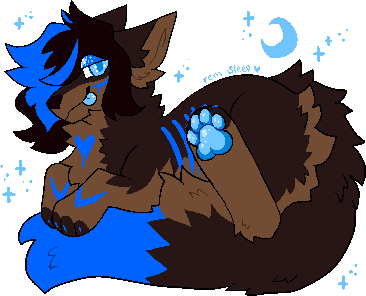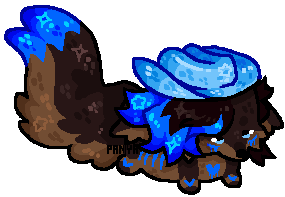Hello and welcome to DRD! 
Not much is known about the Racers, but more will be discovered as more are adopted into homes.
Current Adoptables
-None-
Species Info
Species Name
Desert Racer Dragons, commonly referred to as DRD.
Genus
Armallidos Dracos
Classification
Mammal, though the younger ones are adapted to live inside of cactuses until they reach maturity. After all, babies have severe problems in the tough world of the desert savanna.

Size + Did You Know?
Eggs - The eggs are the size of a bean, they're often mistaken for seeds. If they are planted the colors of the DRDs colors and behavior tend to reflect the seed for which it was mistaken. These are rare and are hard to find. For the most part, DRD aren't planted, though if they are they're very illusive.
Babies - They're usually around the size of a small rat to that of a desert hare. They're very tiny at their youngest and their legs are still very short. At this age they have webbed feet and some various fins and gills on them that vanish when they reach maturity. They gradually eat their way out of their cactus home and by the time they break the wall of the cactus they're big enough to be on their own.
Adolescents - Teenies, as they're commonly called, are in the savanna or breaking the wall by now. These younglings tend to be from the size of a fox to that of a coyote. Depending upon the type of cactus they grew up in and it's overall size also is a factor in the size of the DRD. At this stage they feast upon savanna grass and a bit of whatever they can find, the world isn't the most wonderful place for a lone teenie.
Adults - Once mature they tend to live on their own, now being the size of a small pony. They grow to be very large, though some remain at a teen-like stage and some get bigger. The adult size varies a LOT, but the largest reported was around horse size. The adults eat savanna grass and sometimes littler cactuses far to small to leave a young DRD inside. The adults, once mated, lay eggs inside a cactus and await the cycle to start yet again.
Diet
Savanna Grass
Cactuses, only those too small to host a child.
Desert Hares are seen as a delicacy.
Mating
Once a DRD mates, it mates for LIFE. So no just mating once and leaving. When a DRD mates, the female lays an egg inside a cactus and leaves. The reason for this is DRDs must be raised to be strong, therefore a trial of their worth is their survival from the cactus onward into life. Meanwhile, the parents will stay together and wander the dunes. DRD tend to mate in the cooler season of the desert, but not too cold! Can you guess? Yes, unusually a DRD mates in the fall! Not spring, not summer, certainly not winter. Keep these things in mind when finding a mate for your DRD!
Coloration
Natural Colors - These are very common colors and are the most seen in DRD. These creatures are known for their camouflage ability, so they usually have these colors as a natural defense. Usually the more common colors are around sand colored to deep dust red. These tend to not be as violent as brighter colors.
Bright Colors - These are somewhat uncommon seeing as most of these creatures are more lesser in terms of fighting. The natural DRDs have a natural defense against intruders, while bright colors must resort to violence or fleeing. These DRDs tend to be specialized in one of those areas.
Flower Colors - These are RARE and only occur when a human plants a DRD's egg in mistaking it for a seed. The DRD's personality and markings are influenced by what seed they were mistaken for. Each of these carry a flower somewhere with them, it's most commonly the flower they were originally thought to be. These are very social and LOVE to be around humans. They're not horribly fast or spiteful but they are very intellectual and enjoy problem solving.
White - These are VERY RARE and are very aggressive. They almost have to be, seeing as they stand out so much compared to the hot desert sand. These aren't very commonly spotted and not much is known about them.
Mutations
If a DRD is mutated in any way it means that they're genetically more advanced than the others. Most of the time a mutated DRD is more excelled in some topics than the others. Sometimes they develop horns or spikes, even fur! In rarest cases they will sprout wings or keep their aquatic fins and gills, in which case they must live at an oasis. Though these class as amphibious and can stay on land as well, they just need the water every few hours so they usually hang around bodies of water.
Staff
xXxAkumaSoulxXx ~ Owner, Artist, Awesome
| / m o o n i \ | ~ Artist, Wifey
Hiccup ~ Artist, Hound
ShadowedNight ~ Mod, Honorary Grammar Nazi
Guest Artists
1. ~Mossfire~
2. BloodyCrystal56
3. Teleport
4. Forever - Alone 333
5. Bonus
You can each make two DRDs! Please keep things organized!
Form
Guest artists are chosen every Monday, so stick around to catch a slot!
Note, guest artists cannot create rare WoAs but they can make one for themselves if they don't already own one.
But only if you ask me before then!
Q & A
How do I adopt?
Post a form, we judge on effort and overall love for the DRD. So give it your all and your in the right place!
The general form includes name, gender, personality and sometimes a story or art.
But you can add as much as you want for a chance at victory!
Rules
ø Follow Tess's Rules! That's a bit obvious.
ø Don't whine if you don't win! There will be more folks.
ø We are NOT machines. Sadly, these DRDs do not appear out of nowhere.
ø No art theft! It's not cool.
ø Don't break my stinkin' rules. Obviously.
ø Use your DRD, if not let me adopt it to someone who will.
ø Put effort into your form. Just do it. Or I will sic my HICCUP HOUND on you.
Affiliates

Hiccups original species, Jelly Bean Dragons!
I highly recommend you check them out bro. Like, right now. XD
Post away! Remember, HICCUP HOUND WATCHES YOUR EVERY MOVE!

Not much is known about the Racers, but more will be discovered as more are adopted into homes.
Current Adoptables
-None-
Species Info
Species Name
Desert Racer Dragons, commonly referred to as DRD.
Genus
Armallidos Dracos
Classification
Mammal, though the younger ones are adapted to live inside of cactuses until they reach maturity. After all, babies have severe problems in the tough world of the desert savanna.
Size + Did You Know?
Eggs - The eggs are the size of a bean, they're often mistaken for seeds. If they are planted the colors of the DRDs colors and behavior tend to reflect the seed for which it was mistaken. These are rare and are hard to find. For the most part, DRD aren't planted, though if they are they're very illusive.
Babies - They're usually around the size of a small rat to that of a desert hare. They're very tiny at their youngest and their legs are still very short. At this age they have webbed feet and some various fins and gills on them that vanish when they reach maturity. They gradually eat their way out of their cactus home and by the time they break the wall of the cactus they're big enough to be on their own.
Adolescents - Teenies, as they're commonly called, are in the savanna or breaking the wall by now. These younglings tend to be from the size of a fox to that of a coyote. Depending upon the type of cactus they grew up in and it's overall size also is a factor in the size of the DRD. At this stage they feast upon savanna grass and a bit of whatever they can find, the world isn't the most wonderful place for a lone teenie.
Adults - Once mature they tend to live on their own, now being the size of a small pony. They grow to be very large, though some remain at a teen-like stage and some get bigger. The adult size varies a LOT, but the largest reported was around horse size. The adults eat savanna grass and sometimes littler cactuses far to small to leave a young DRD inside. The adults, once mated, lay eggs inside a cactus and await the cycle to start yet again.
Diet
Savanna Grass
Cactuses, only those too small to host a child.
Desert Hares are seen as a delicacy.
Mating
Once a DRD mates, it mates for LIFE. So no just mating once and leaving. When a DRD mates, the female lays an egg inside a cactus and leaves. The reason for this is DRDs must be raised to be strong, therefore a trial of their worth is their survival from the cactus onward into life. Meanwhile, the parents will stay together and wander the dunes. DRD tend to mate in the cooler season of the desert, but not too cold! Can you guess? Yes, unusually a DRD mates in the fall! Not spring, not summer, certainly not winter. Keep these things in mind when finding a mate for your DRD!
Coloration
Natural Colors - These are very common colors and are the most seen in DRD. These creatures are known for their camouflage ability, so they usually have these colors as a natural defense. Usually the more common colors are around sand colored to deep dust red. These tend to not be as violent as brighter colors.
Bright Colors - These are somewhat uncommon seeing as most of these creatures are more lesser in terms of fighting. The natural DRDs have a natural defense against intruders, while bright colors must resort to violence or fleeing. These DRDs tend to be specialized in one of those areas.
Flower Colors - These are RARE and only occur when a human plants a DRD's egg in mistaking it for a seed. The DRD's personality and markings are influenced by what seed they were mistaken for. Each of these carry a flower somewhere with them, it's most commonly the flower they were originally thought to be. These are very social and LOVE to be around humans. They're not horribly fast or spiteful but they are very intellectual and enjoy problem solving.
White - These are VERY RARE and are very aggressive. They almost have to be, seeing as they stand out so much compared to the hot desert sand. These aren't very commonly spotted and not much is known about them.
Mutations
If a DRD is mutated in any way it means that they're genetically more advanced than the others. Most of the time a mutated DRD is more excelled in some topics than the others. Sometimes they develop horns or spikes, even fur! In rarest cases they will sprout wings or keep their aquatic fins and gills, in which case they must live at an oasis. Though these class as amphibious and can stay on land as well, they just need the water every few hours so they usually hang around bodies of water.
Staff
xXxAkumaSoulxXx ~ Owner, Artist, Awesome
| / m o o n i \ | ~ Artist, Wifey
Hiccup ~ Artist, Hound
ShadowedNight ~ Mod, Honorary Grammar Nazi
Guest Artists
1. ~Mossfire~
2. BloodyCrystal56
3. Teleport
4. Forever - Alone 333
5. Bonus
You can each make two DRDs! Please keep things organized!
Form
- Code: Select all
[b]GUEST ARTIST! /stalker[/b]
[b]Username :[/b]
[b]Have you been a quest artist before?[/b] Yes / No
Guest artists are chosen every Monday, so stick around to catch a slot!
Note, guest artists cannot create rare WoAs but they can make one for themselves if they don't already own one.
But only if you ask me before then!
Q & A
How do I adopt?
Post a form, we judge on effort and overall love for the DRD. So give it your all and your in the right place!
The general form includes name, gender, personality and sometimes a story or art.
But you can add as much as you want for a chance at victory!
Rules
ø Follow Tess's Rules! That's a bit obvious.
ø Don't whine if you don't win! There will be more folks.
ø We are NOT machines. Sadly, these DRDs do not appear out of nowhere.
ø No art theft! It's not cool.
ø Don't break my stinkin' rules. Obviously.
ø Use your DRD, if not let me adopt it to someone who will.
ø Put effort into your form. Just do it. Or I will sic my HICCUP HOUND on you.
Affiliates

Hiccups original species, Jelly Bean Dragons!
I highly recommend you check them out bro. Like, right now. XD
Post away! Remember, HICCUP HOUND WATCHES YOUR EVERY MOVE!



























